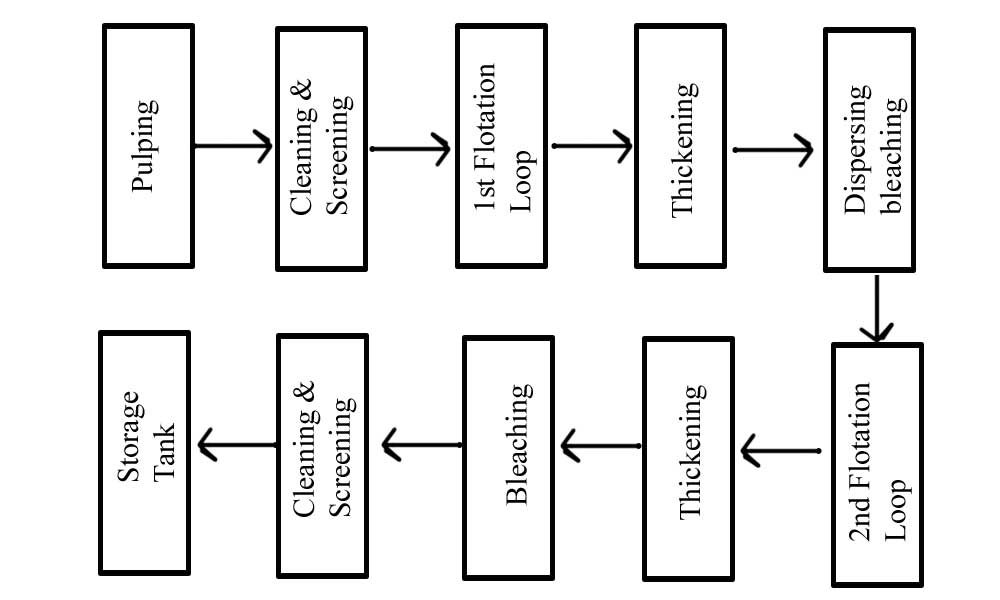Deinking process is the process that eliminating printing ink from recycled fibers to produce deinked pulp. This process can be achieved by a combination of mechanical and chemical action. There are different types of waste paper such as office waste (OW), Old Magazine Papers (OMP), Old newsprint (ONP), telephone directories, catalogs, box-board cuttings, paperboard etc. Most type of recycle fiber has some sort of printing on the recycled paper. Depending on the kind of recycle paper and the nature of the end product, different types of deinking process are applied. Here we describe some common type of them. At first the waste paper must be disintegrated in order to deinking. The pH is usually kept between 7.5 and 10.0.
Flotation deinking process
Flotation deinking is the most common type deinking of paper process for paper making. In this process ink is eliminated from the waste paper pulp by adding chemicals like surfactants. The ink is a hydrophobic component, so it is attract by the surfactants. After adding the surfactants the air introduce into the recovered pulp. Then the ink particles that are detached from the fiber will float and mix with the foam on the water surface. This foam is then removed from the vat. After Flotation deinking some paper mills add another section bleaching section in order to increase brightness of the pulp. Some paper mill used second flotation loop for removing extra ink. Flotation deinking is used for the deinking of graphic papers such as newsprint and magazine papers. The most common Europeans process is froth flotation deinking.

Bleach deinking
The bleaching type of deinking process is applied to destroy colorants in inks and to produce the pulp of higher brightness for quality paper. In this process many paper mill use hydrogen peroxide and sodium dithionite (which is also known as sodium hydrosulfite) type bleaching agents. These bleaching agents can be used during pulping step or in a completely different bleaching step.
Enzymatic Deinking
The enzymatic deinking method uses enzymes in combination with flotation deinking to increase ink removal. This is an environmentally friendly process. It selectively modifies cellulose fibers to help separate ink and other debris from waste paper pulp. The deinking enzymes are lipases, esterases, pectinases, hemicelluloses, cellulose, and ligninolytic. Among them Lipases and esterases degrade vegetable-oil-based inks. Pectinases, hemicellulose, cellulose, and ligninolytic enzymes alter the fiber surface or bonds in the vicinity of the ink particles, thereby freeing ink for removal by washing or flotation. This process reduce required amount of alkali and detergent to releases embedded ink from the secondary fibers. If the recycle fiber contains adhesive elements, it can obstacle the paper-making process because this element tend to deposit on fabrics, wires, felts and rolls which leads to different problems likes paper breaks, holes, sheet defects etc. This process improves pulp cleaning, machine running capacity, improves drainage and reduced dust. The main defect observed is the high COD level of the process water. The brightness is very low due to the lack of bleaching agent.
Wash Deinking
In this method the waste paper pulp is soaked in water and passed over a wire screen. This screen remove ink and other unwanted ingredients like mineral fillers. Pulp fibers are recovered from the screen and the filtered material is further treated to remove more unwanted solids. Washing is only effective in removing small particle-sized ink and is not intended for use on high or even moderately printed papers. The main drawback of this process is that the medium to small particles are washed out. So it is not useful for most of the paper.
Conclusion
The quality and effectiveness of the fiber remains up to 4 or 5 times recycle. After deinking process the fiber losses its strength related properties, bonding capacity, purity and quality; so it is better to mix with virgin fiber for producing quality paper.
Sources:
https://en.wikipedia.org/wiki/Deinking
https://www.sciencedirect.com/topics/agricultural-and-biological-sciences/deinking
https://www.capitalmds.com/deinking-of-paper/

we need price of deinking pulp and the specification of it